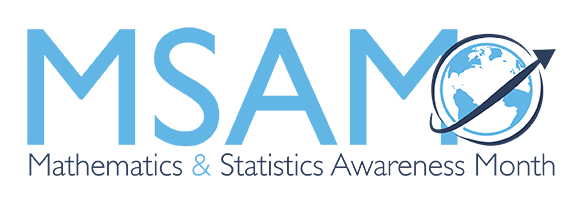
About Mathematics and Statistics Awareness Month
Mathematics Awareness Month began in 1986 as Mathematics Awareness Week with a proclamation by President Ronald Reagan, who said in part:
Despite the increasing importance of mathematics to the progress of our economy and society, enrollment in mathematics programs has been declining at all levels of the American educational system. Yet the application of mathematics is indispensable in such diverse fields as medicine, computer sciences, space exploration, the skilled trades, business, defense, and government. To help encourage the study and utilization of mathematics, it is appropriate that all Americans be reminded of the importance of this basic branch of science to our daily lives.
In 1986, activities concentrated on national-level events, such as opening an exhibit at the Smithsonian Institution on mathematics and hosting a Capitol Hill reception. In 1999, Mathematics Awareness Week became Mathematics Awareness Month, held each year in April. Since that time, the focus has shifted to activities at the local, state, and regional levels. Over the years, the general purpose has consistently been to increase the visibility of mathematics as a field of study and communicate the power and intrigue in mathematics to a larger audience. Its goal is to increase public understanding of and appreciation for mathematics. Starting in 2017, the month's theme is Mathematics and Statistics Awareness Month, to celebrate mathematics and statistics and the diverse researchers and students in these fields who are contributing so much to furthering discoveries, solving problems, and finding beauty in our world.
The Math Forum hosted the Mathematics Awareness Month website until 2005.
Activities
Activities for Mathematics and Statistics Awareness Month are generally organized by college and university departments, institutional public information offices, student groups, and related associations and interest groups. They have included a wide variety of workshops, competitions, exhibits, festivals, lectures, and symposia. In some years, elected officials have issued proclamations for Mathematics Awareness Month, frequently in connection with special meetings and events arranged to observe the month.
The number and breadth of activities increase annually. For example, one college has sponsored a high-school mathematics day to encourage women to continue their studies in mathematics. At one university, two departments—mathematics and architecture—cooperated to plan and produce an interactive traveling exhibit that provided hands-on experience for such topics as codes, tilings, chaos, geometry, graphs, and computer science. That exhibit was used as a model for a mathematics exhibit at the Baltimore Museum of Science and Industry.
High schools are also involved in awareness activities. One school held daily contests, including a scavenger hunt and trivia quizzes, while others have enjoyed lectures given by mathematics faculty from nearby institutions.
Themes
In past years, a theme was selected, theme materials were developed and distributed, and groups shared their activities on the website.
To focus efforts and encourage participation, Mathematics and Statistics Awareness Month now offers resources for department chairs, selected high-school teachers, public policy representatives, and leaders of related associations to use and share throughout April—and throughout the year. JPBM welcomes the sharing of additional resources, supplemental links, updates, and activities on social media using #MathStatMonth.
Mathematics and Statistics Awareness Month information reaches thousands of faculty members, teachers, students, parents, public policy leaders, business persons, and other community members.